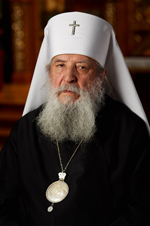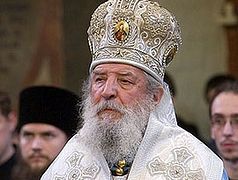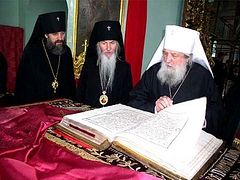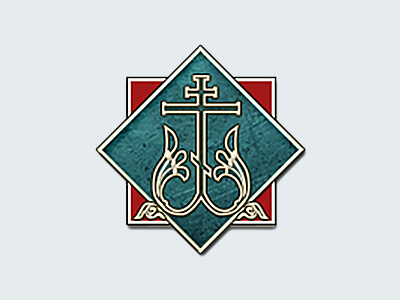 1. Your Eminence, the events of May 17 have already entered the history books as a day when by Divine mercy, the reunification of the Russian Orthodox Church took place. How do you look back on those days now? What was the most vivid impression you were left with?
1. Your Eminence, the events of May 17 have already entered the history books as a day when by Divine mercy, the reunification of the Russian Orthodox Church took place. How do you look back on those days now? What was the most vivid impression you were left with?
The biggest impression on me was the divine service in the heart of Russian Orthodoxy, under the vaulted ceilings of the grandiose Uspensky Cathedral of the Mother of God, the resting place of the Moscow Primates. Here lies St Ermogen, a shining example of staunchness in the Orthodox Faith during the Time of Troubles. His guidance led our ancestors to stand firmly for their faith, their Fatherland, and during his imprisonment, yet with his blessing, Archimandrite Dionisy of Holy Trinity-St Sergius Lavra and Avraamy Palitsyn, his protector, sent missives to inspire the defenders of the Muscovite state. I felt then that even after the second Time of Troubles, we must root out internecine strife and restore truth, peace and Divine truth within our hearts.
Personally, I feel connection with that cathedral because here, over a hundred years ago, the second Primate of our Russian Orthodox Church Outside of Russia, Metropolitan Anastassy (Gribanovsky) of blessed memory was ordained as Bishop of Serpukhov. At one time, I had the honor of being an altar boy when he served. During his nomination, in accordance with tradition, he gave a sermon, in which he gave a remarkably powerful and artistic outline of “the path of a true pastor of Christ,” and in a surge of inspiration foretold the bloody strife that would befall the Russian Orthodox Church in the years of the Revolution. In his epistles, he grieved over the tragedy of our common history, denounced the lies of the atheists, praised the martyrs and confessors who suffered the persecutions, and rejoiced when the religious people of Russia felt joy, support and consolation. In particular, I remember one of the first church services at the New Kursk-Root Hermitage in New York, in which I participate as a Hieromonk, serving together with Metropolitan Anastassy, during which he announced to all with great joy that the holy relics of St Sergius of Radonezh were returned to the people of the Church, expressing hope that this event would strengthen the Russian people, suffering at the time from persecutions. Vladyka Anastassy was worthy of his high calling, for he served the Church of Christ with no regard for himself, he observed the faith and cherished peace throughout his life. He loved this ancient cathedral, and, as a Vicar of the Moscow Diocese, he often conducted services here. It is interesting to note that during the canonization of St Ermogen, in 1913, the future First Hierarch of the Russian Church Abroad, then still a young bishop, was charged with delivering the sermon, despite the fact that over 20 bishops participated in the ceremonies. So it was especially joyful for me to serve in this holy temple.
2. In your opinion, what further steps need to be taken to strengthen the unity of the Russian Orthodox Church?
First of all, through the joint celebration of the Eucharist, we must bear witness that we form one unified body, one spirit, one Church, and that within us is the One Christ, our God (1 Corinthians 12:12-20, Ephesians 4:4). All of mankind is called upon to be the “the whole race of Adam,” as we hear in the Paschal canon. “The whole race of Adam” is all of mankind in Christ. When we pray during Divine Liturgy, our thoughts and feelings must be concentrated upon one thing—prayer to God. Joint prayer in church, and pious communion, firmly unify people in Christ and, as a society, unify them with Christ. That is why we must strengthen and develop church unity through frequent joint prayer, which will lead to fuller trust, closer relations and active brotherly cooperation. Only in this way can we, emerging from the temple, then continue upon this wondrous, mysterious meeting with Christ in our deeds, in our lives.
3. It is still not easy for us in Russia to learn about the life of the Church Abroad. When events over the last year do you see as the most important, and why?
In my opinion, one of the main events of this year of Divine mercy, besides the reestablishment of church unity, was the tour of the “Reigning” Icon of the Mother of God throughout the dioceses of the Russian Orthodox Church Outside of Russia, accompanied by a delegation of the Moscow Patriarchate and the choir of Sretensky Stavropighial Monastery in Moscow, which participated in the divine services in celebration of the reestablishment of the fullness of brotherly communion within the Russian Orthodox Church. This event brought great benefit to the Church and the great work of its unity. Members of the official delegation, Sretensky Choir, the clergy and laity of our churches looked each other in the eye and became convinced that they are related by blood, related by faith.
The Enemy of our salvation uses the following weapon in his war against mankind: wishing to sow discord among men, he first separates them physically. Then he sings a song of deceit to one, and another song to the other. I have lived in a monastery for over 60 years and see how such temptations occur within our monastery. For instance, one brother expresses his negative thoughts about another monk to his spiritual father. Then the other monk comes to the same father and criticizes the first. Then, if the spiritual father possesses wisdom and pastoral experience, he advises that the brothers meet and talk to each other. The snares of the devil are often revealed during such a meeting, and the devil retreats, while peace and brotherly love are restored.
That is how the devil managed to divide us and scatter us throughout the world. Our brothers and sisters in Russia lived and served under persecution, while we carried out our service in freedom, but still, in exile. At that time there was no opportunity for joint prayer or contact, and there was no trust between us. After the fall of the communist regime, we began to have some contact—true, it was unofficial—but in any case we again had the chance to see each other, meet and talk. This informal contact helped us get to know each other, learn about church life of the other side, and see that we are all children of the Russian Orthodox Church. The enemy then began to retreat, and, with God’s help, we arrived at unity.
Divine services and meetings which were held in our dioceses before the Reigning Icon convinced many of this unity, many came to see that we all—on both sides—love and suffer for our Russian Orthodox Church.
Thank God, we have found within ourselves the strength to restore ecclesiastical unity. Now we must strengthen it through common prayer, brotherly meetings and constructive cooperation.
4. What is the relationship within your flock between those who are of Russian descent and those who accepted Holy Orthodoxy having come from other Christian churches? How do you think their relationships might change, if they do?
The old emigrants and their descendants comprise the majority of our parishioners; then the new immigrants and their children; then the newly-converted, who mainly participate in the life of our missions. Will their relationships change? It is difficult to say. In any case, we work with all of them, preserving and increasing the great legacy of Holy Russia that we have been given.
Thank God, our parishes have Russian parish schools in which children are taught the basic truths of our faith, Russian language, Russian literature and history; there are youth circles led by good pastors, who call upon young people to love the Church and the Fatherland. There are summer camps and youth conferences throughout the globe. Parents try to speak only Russian with their children and follow the Russian Orthodox way of life. This is a great feat, performed under difficult circumstances.
In a word, our goal is not only to preserve but to increase among our children that which we have, to serve the Russian Orthodox Church, help her witness the Truth of Christ and speak the great word of Holy Russia to the whole world. We intend to continue the salvific service to God and to the people of the Russian Orthodox Church Outside of Russia.
5. How do your parishioners in America view the Russian Orthodox Church? Do they have enough information to independently form their own opinions?
The image of the Russian Orthodox Church is one of the martyrs and confessors of Russia gradually rising out of the ruins of the Church. This is exactly how many think. Although there is more than enough information about church life in Russia, not all the older immigrants have access to the internet, where such materials are published. That is why I would say that they do not have enough information, but most of all they lack the living contact with clergymen and people of the Church in Russia. Without that it is difficult for people to form an objective opinion. That is why we ask that you come to us, as we for several years have been coming to Russia.
6. In your view, what are the perspectives for further developing contact between the Church Abroad and the Orthodox parishes in Russia? What spiritual and practical ecclesiastical benefits could such contacts bring?
There are two prime areas where parishes abroad can cooperate with those of the Fatherland to their mutual benefit—first of all, in the area of church schools and work with youth, and secondly in establishing parishes and parish life. I envision joint summer children’s camps, youth choir competitions, visiting parish schools, etc. There has already been an exchange of textbooks: the Law of God, by a priest of the Church Abroad, Fr Seraphim Slobodskoy, is now distributed everywhere in Russia today, and the teaching of Russian language, literature and history abroad is now unimaginable without teaching materials from Russia. For more effective cooperation, we need living contact between parish priests, the exchange of experiences. Conferences for priests of both the Russian Orthodox Church Outside of Russia and the Moscow Patriarchate, joint youth conferences, these are projects that we should take on.
7. There are Old Believer parishes in the Church Abroad. Can you tell us about them: how many parishes and communities are there? Do they lead their church lives separately from you?
There is an Erie, PA, Old Believer Vicariate which is entrusted to me in the Diocese of Eastern America and New York, which has a very populous community tended to by Bishop Daniel and his clerics. Yes, they live their own life, observing the Old Rite and traditions, but I would not say that they lead a separate life. They participate in our ceremonies, conferences, etc. For instance, next year, Protopriest Pimen Simon, Rector of the Church of the Nativity of Christ in Erie, is organizing an All-Orthodox Conference called “Orthodoxy in the 21 st Century,” with the participation of eminent scholarly bishops, clergymen and laypersons. It is scheduled to coincide with the 25 th anniversary of the joining of the Erie community to the Russian Orthodox Church Outside of Russia.
It is interesting to note that Fr Pimen was one of the participants of the IV All-Diaspora Council. It was his speech that helped many of the Council members to understand the need to reestablish church unity. He told of his move from the bezpopovtsi [priestless sect] to the Church of Christ. The fact of the matter is that his close friend and the translator of many Old Believer texts for publication in the USA, Fr German (Ciuba), often told him that the Church has so many urgent matters that it was time to stop the endless arguments about the acts of Patriarch Nikon, and that the persecutions of Old Believers should be left in the past and left to God’s judgment. In the 1970’s, when the Moscow Patriarchate and the Russian Orthodox Church Outside of Russia lifted their anathemas of the Old Believers, Fr Pimen contacted then-Hieromonk Hilarion, later Archbishop of Australia and New Zealand, who then conducted his monastic labors at our Holy Trinity Monastery in Jordanville, NY. Father Hilarion showed him love and true Orthodoxy. When Fr Pimen’s community joined the Church and accepted the priesthood in 1983, there was discord among its people. Some left. There were those who publically denounced the move. Some spat upon his wife and other members of his family in public. In other words, he endured the pain and suffering of division. At the Council, he drew the parallels between the efforts towards reconciliation between the Russian Church Abroad and the Moscow Patriarchate, and the efforts to reconcile the Old Believers with the “Nikonites.” Every argument he heard at the Council sounded like the quarrel between adherents of the Old Rite and the New Rite, which has continued for centuries. He also said that of course there would be differences, there would be stubbornness, resistance to following sound logic, there would be rumor-mongering and even divisions. But if there is truth in the reestablishment of unity within the Russian Church, then we must find the courage within ourselves to bring it into being. If this is the will of God, then we will be saved and in complete safety. So by speaking, our Old-Rite priest made a great contribution to our conciliar work.
8. Among the latest events of 2007 was the December program of the Publishing Department of the Russian Orthodox Church held in Washington and New York. How important in your view were these events, and especially the exhibition on the history of Russian Orthodoxy in the 20 th century?
The exhibition on the latest period of our common history, without a doubt, will have a positive effect on the relationship between Russia and America, and will give Americans an understanding of what the Russian Orthodox Church is, of the piety of our people, of our divine services. This exhibit will give many an idea of the podvigi and sufferings of our people, of our Church, of our martyrs, the suffering and death of whom, I hope, will leave an indelible impression in the heart of each visitor.
NEW YORK: December 13, 2007



